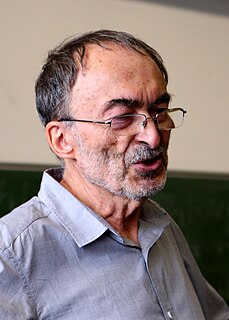This page is based on this
Wikipedia article Text is available under the
CC BY-SA 4.0 license; additional terms may apply.
Images, videos and audio are available under their respective licenses.

In mathematics, the p-adic number system for any prime number p extends the ordinary arithmetic of the rational numbers in a different way from the extension of the rational number system to the real and complex number systems. The extension is achieved by an alternative interpretation of the concept of "closeness" or absolute value. In particular, p-adic numbers are considered to be close when their difference is divisible by a high power of p: the higher the power, the closer they are. This property enables p-adic numbers to encode congruence information in a way that turns out to have powerful applications in number theory – including, for example, in the famous proof of Fermat's Last Theorem by Andrew Wiles.
In mathematics, a local field is a special type of field that is a locally compact topological field with respect to a non-discrete topology.
Given such a field, an absolute value can be defined on it. There are two basic types of local fields: those in which the absolute value is Archimedean and those in which it is not. In the first case, one calls the local field an Archimedean local field, in the second case, one calls it a non-Archimedean local field. Local fields arise naturally in number theory as completions of global fields.
In mathematics, specifically in homology theory and algebraic topology, cohomology is a general term for a sequence of abelian groups associated to a topological space, often defined from a cochain complex. Cohomology can be viewed as a method of assigning richer algebraic invariants to a space than homology. Some versions of cohomology arise by dualizing the construction of homology. In other words, cochains are functions on the group of chains in homology theory.
In mathematics, the Weil conjectures were some highly influential proposals by André Weil (1949), which led to a successful multi-decade program to prove them, in which many leading researchers developed the framework of modern algebraic geometry and number theory.

In mathematics, p-adic analysis is a branch of number theory that deals with the mathematical analysis of functions of p-adic numbers.
In algebraic geometry, motives is a theory proposed by Alexander Grothendieck in the 1960's to unify the vast array of similarly behaved cohomology theories such as singular cohomology, de Rham cohomology, etale cohomology, and crystalline cohomology. Philosophically, a 'motif' is the 'cohomology essence' of a variety.
In mathematics, a Galois module is a G-module, with G being the Galois group of some extension of fields. The term Galois representation is frequently used when the G-module is a vector space over a field or a free module over a ring, but can also be used as a synonym for G-module. The study of Galois modules for extensions of local or global fields is an important tool in number theory.

In mathematics, arithmetic geometry is roughly the application of techniques from algebraic geometry to problems in number theory. Arithmetic geometry is centered around Diophantine geometry, the study of rational points of algebraic varieties.
In mathematics an even integer, that is, a number that is divisible by 2, is called evenly even or doubly even if it is a multiple of 4, and oddly even or singly even if it is not.
This is a glossary of arithmetic and diophantine geometry in mathematics, areas growing out of the traditional study of Diophantine equations to encompass large parts of number theory and algebraic geometry. Much of the theory is in the form of proposed conjectures, which can be related at various levels of generality.
In mathematics, crystalline cohomology is a Weil cohomology theory for schemes X over a base field k. Its values Hn(X/W) are modules over the ring W of Witt vectors over k. It was introduced by Alexander Grothendieck and developed by Pierre Berthelot (1974).
In number theory, a cyclotomic character is a character of a Galois group giving the Galois action on a group of roots of unity. As a one-dimensional representation over a ring R, its representation space is generally denoted by R(1).
In mathematics, a p-adic zeta function, or more generally a p-adic L-function, is a function analogous to the Riemann zeta function, or more general L-functions, but whose domain and target are p-adic. For example, the domain could be the p-adic integers Zp, a profinite p-group, or a p-adic family of Galois representations, and the image could be the p-adic numbers Qp or its algebraic closure.

Jean-Marc Fontaine was a French mathematician. He was one of the founders of p-adic Hodge theory. He was a professor at Paris-Sud 11 University from 1988 to his death.
In mathematics, an algebraic number field F is a finite degree field extension of the field of rational numbers Q. Thus F is a field that contains Q and has finite dimension when considered as a vector space over Q.

Christopher Deninger is a German mathematician at the University of Münster.



